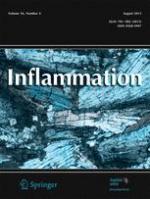Citation:
Ginsburg I, Mitra RS, Gibbs DF, Varani J, Kohen R. Killing of endothelial cells and release of arachidonic acid. Synergistic effects among hydrogen peroxide, membrane-damaging agents, cationic substances, and proteinases and their modulation by inhibitors. Inflammation. 1993;17 (3) :295-319.

Abstract:
51Chromium-labeled rat pulmonary artery endothelial cells (EC) cultivated in MEM medium were killed, in a synergistic manner, by mixtures of subtoxic amounts of glucose oxidase-generated H2O2 and subtoxic amounts of the following agents: the cationic substances, nuclear histone, defensins, lysozyme, poly-L-arginine, spermine, pancreatic ribonuclease, polymyxin B, chlorhexidine, cetyltrimethyl ammonium bromide, as well as by the membrane-damaging agents phospholipases A2 (PLA2) and C (PLC), lysolecithin (LL), and by streptolysin S (SLS) of group A streptococci. Cytotoxicity induced by such mixtures was further enhanced by subtoxic amounts either of trypsin or of elastase. Glucose-oxidase cationized by complexing to poly-L-histidine proved an excellent deliverer of membrane-directed H2O2 capable of enhancing EC killing by other agonists. EC treated with rabbit anti-streptococcal IgG were also killed, in a synergistic manner, by H2O2, suggesting the presence in the IgG preparation of cross-reactive antibodies. Killing of EC by the various mixtures of agonists was strongly inhibited by scavengers of hydrogen peroxide (catalase, dimethylthiourea, MnCl2), by soybean trypsin inhibitor, by polyanions, as well as by putative inhibitors of phospholipases. Strong inhibition of cell killing was also observed with tannic acid and by extracts of tea, but less so by serum. On the other hand, neither deferoxamine, HClO, TNF, nor GTP gamma S had any modulating effects on the synergistic cell killing. EC exposed either to 6-deoxyglucose, puromycin, or triflupromazin became highly susceptible to killing by mixtures of hydrogen peroxide with several of the membrane-damaging agents. While maximal synergistic EC killing was achieved by mixtures of H2O2 with either PLA2, PLC, LL, or with SLS, a very substantial release of [3H]arachidonic acid (AA), PGE2, and 6-keto-PGF occurred only if a proteinase was also added to the mixture of agonists. The release of AA from EC was markedly inhibited either by scavengers of H2O2, by proteinase inhibitors, by cationic agents, by HClO, by tannic acid, and by quinacrin. We suggest that cellular injury induced in inflammatory and infectious sites might be the result of synergistic effects among leukocyte-derived oxidants, lysosomal hydrolases, cytotoxic cationic polypeptides, proteinases, and microbial toxins, which might be present in exudates. These "cocktails" not only kill cells, but also solubilize AA and several of its metabolites. However, AA release by the various agonists can be also achieved following attack by leukocyte-derived agonists on dead cells. It is proposed that treatment by "cocktails" of adequate antagonists might be beneficial to protect against cellular injury in vivo.Publication Global ID: http://www.ncbi.nlm.nih.gov/pubmed/8330929

